How Pharmacy Work Stopped Being So Great

If any group of workers might have expected their pay to rise last year, it would arguably have been pharmacists. With many drugstores dispensing coronavirus tests and vaccines while filling hundreds of prescriptions each day, working as a pharmacist became a sleep-deprived, lunch-skipping frenzy — one in which ornery customers did not hesitate to vent their frustrations over the inevitable backups and bottlenecks.
“I was stressed all day long about giving immunizations,” said Amanda Poole, who left her job as a pharmacist at a CVS in Tuscaloosa, Ala., in June. “I’d look at patients and say to them, ‘I’d love to fill your prescriptions today, but there’s no way I can.’”
Yet pay for pharmacists, who typically spend six or seven years after high school working toward their professional degree, fell nearly 5 percent last year after adjusting for inflation. Dr. Poole said her pay, about $65 per hour, did not increase in more than four years — first at an independent pharmacy, then at CVS.
For many Americans, one of the pandemic’s few bright spots has been wage growth, with pay rising rapidly for those near the bottomand those at the top. But a broad swath of workers in between has lagged behind.
In the two years after February 2020, income for those between the middle and the top tenth of earners grew less than half as quickly as income for those in the top 1 percent, according to data collected by a team of economists at the University of California, Berkeley.
The gap is part of a long-term trend made worse by a slowdown in pay gains for middle- and upper-middle-income workers in the 2000s. “If you’re going to a hedge fund or investment bank or a tech company, you’ve done enormously well,” said Lawrence Katz, a labor economist at Harvard. Typical college graduates, he said, “have not done that great.”
The stagnation appears to have moved up the income ladder in the last few years, even touching those in the top 10 percent.
In some cases, the explanation may be a temporary factor, like inflation. But pharmacists illustrate how slow wage growth can point to a longer-term shift that renders once sought-after jobs less rewarding financially and emotionally.
Growing Chains, Falling Wages
In 2018, Suzanne Wommack moved from western Missouri, where she had worked for several years as a pharmacist at a Hy-Vee supermarket, to the eastern part of the state, where she and her husband had relatives. The job she landed as a Walgreens pharmacy manager in Hannibal, roughly an hour-and-a-half outside St. Louis, paid her about $62 per hour — nearly $6 below her previous hourly wage, though regional pay differences helped to explain the drop.
More striking was how few pharmacists Walgreens appeared to employ. At Hy-Vee, Dr. Wommack worked with one or two other pharmacists for most of the day. At Walgreens, the volume of business was similar, she said, but she was almost always the only pharmacist on duty during her shift, which often ran from 8 a.m. until the pharmacy closed at 8 p.m.
Inflation F.A.Q.
Inflation F.A.Q.
What is inflation? Inflation is a loss of purchasing power over time, meaning your dollar will not go as far tomorrow as it did today. It is typically expressed as the annual change in prices for everyday goods and services such as food, furniture, apparel, transportation and toys.
Inflation F.A.Q.
What causes inflation? It can be the result of rising consumer demand. But inflation can also rise and fall based on developments that have little to do with economic conditions, such as limited oil production and supply chain problems.
Inflation F.A.Q.
Is inflation bad? It depends on the circumstances. Fast price increases spell trouble, but moderate price gains can lead to higher wages and job growth.
Inflation F.A.Q.
How does inflation affect the poor? Inflation can be especially hard to shoulder for poor households because they spend a bigger chunk of their budgets on necessities like food, housing and gas.
Inflation F.A.Q.
Can inflation affect the stock market? Rapid inflation typically spells trouble for stocks. Financial assets in general have historically fared badly during inflation booms, while tangible assets like houses have held their value better.
“I had to quit breastfeeding within a month of starting because I could never pump or eat enough to sustain milk,” Dr. Wommack, who had given birth to her third child a few months before taking the new job, said in an email. She said she later began taking anti-anxiety medication and antidepressants to cope with stress at work.
The job market Dr. Wommack encountered was a stark reversal from a decade earlier. In the 2000s, wages in the profession surged as the country faced a pharmacist shortage driven by an aging population and a rise in chronic conditions.

Suzanne Wommack said she began taking anti-anxiety medication and antidepressants to cope with stress at work as a pharmacist for Walgreens.Credit…Whitney Curtis for The New York Times
Universities ramped up enrollment in pharmacy programs, leading to a fivefold increase in graduates — to roughly 10,000 new pharmacists — in the decade that ended in 2007. (Pharmacists typically take two or three years of college-level prerequisites before earning a four-year professional degree.)
But by the 2010s, the market for pharmacists was cooling thanks to some of the same factors that have weighed on other middle-class professions. Large chains such as Walgreens and CVS were buying up competitors and adjacent businesses like health insurers.
This consolidation generated large fees for workers at the top of the income ladder — financiers and corporate lawyers — but slowed the growth of retail outlets where pharmacists could find employment. After striking a deal in 2017 to acquire roughly 2,000 Rite Aid stores, Walgreens shut down more than 500 locations. It closed a few hundred more over the next three years.
Automation has further reduced demand for workers — many pharmacists now spend far less time processing insurance claims because software does it for them.
Pharmacies also faced external challenges. To hold down the cost of prescription drugs, insurance companies and employers rely on so-called pharmacy benefit managers to negotiate discounts with drugmakers and pharmacies. Consolidation among benefit managers gave them more leverage over pharmacies to drive prices lower. (CVS merged with a large benefits manager in 2007.)
Big drugstore chains often responded by trying to rein in labor costs, according to William Doucette, a professor of pharmacy practice at the University of Iowa. Several pharmacists who worked at Walgreens and CVS said the formulas their companies used to allocate labor resulted in low levels of staffing that were extremely difficult to increase.
According to documents provided by a former CVS pharmacist, managers are motivated by bonuses to stay within these aggressive targets. CVS said it made staffing decisions to ensure “the safe and accurate filling of prescriptions.”
More Business, Fewer Hands
The day that Dr. Poole began seriously reconsidering her CVS job in Tuscaloosa came in May 2021 when, nearly eight months pregnant, she fainted at work.
The loss of consciousness was nothing serious in itself — she and the baby were unharmed, and an adjustment to her blood-pressure medication solved the problem. Much more alarming to her was what the episode said about working conditions: Despite the additional responsibilities of the pandemic, like coronavirus vaccines and catering to Covid-19 patients, there was no co-worker around to notice that she had hit the deck.
“No one knew I was passed out until a customer, said, ‘Um, is anyone back in the pharmacy?’” Dr. Poole recalled. “They found me on the ground.”
In most cases, an industry without enough workers to meet customer demand would simply hire more, or at least raise wages to attract them.
Yet, according to the Bureau of Labor Statistics, neither of those things happened last year. The number of pharmacists employed in the United States dropped about 1 percent from 2020 to 2021. On balance, employers did not raise wages — in fact, median pay fell slightly, even without adjusting for inflation.
While this data is not yet available for 2022, a contract signed in March by a union of Chicago-area Walgreens pharmacists reflected a similar approach. It provided maximum base pay of $64.50 per hour, the same as the previous contract, but lowered the starting wage from $58 per hour to $49.55 per hour by September. (Like many retail pharmacists, the union members also receive bonuses.)
CVS and Walgreens said they had made hiring pharmacists a priority during the pandemic — CVS said it employed nearly 6 percent more pharmacists today than it did in early 2020; Walgreens declined to provide a figure. CVS said its compensation was “very competitive” for pharmacists, and Walgreens cited “ongoing phased wage increases”; both chains have offered signing bonuses to recruit pharmacists. The Chicago union said Walgreens had recently offered to raise pay for about one-quarter of its lowest-paid members.
To explain the wage stagnation of upper-middle-class workers during the pandemic, some economists have suggested that affluent workers are willing to accept lower wage growth for the ability to work from home. Dr. Katz, of Harvard, said the wages of many affluent workers might simply be slower to adjust to inflation than the wages of lower-paid workers.
But Marshall Steinbaum, an economist at the University of Utah, said the fact that upper-middle-class workers were not able to claim a larger share of last year’s exceptionally high corporate profits “speaks to the disempowerment of workers at all levels of status.”
Late last year, CVS announced that it planned to shut 900 stores, or nearly 10 percent of its locations, by 2024. Steven Valiquette, an equity analyst at Barclays, suggested the move was partly intended to hold down the wage bill for pharmacists and other personnel. “It was well timed to take labor pressure off the franchise,” Mr. Valiquette said in an interview. (CVS said it retained 95 percent of the employees from the stores it closed this year.)
When drugstores have added personnel during the pandemic, they have often added pharmacy technicians, who help fill prescriptions, instead of pharmacists, effectively replacing costly workers with less costly ones.
In late 2020, Sarah Knolhoff, then a pharmacist at a Walgreens in Rockford, Ill., received an email from management announcing that it was planning to hire several pharmacists in her area to help administer Covid vaccines. But the positions never materialized. The company later announced that a change in state regulations would allow pharmacy technicians to administer shots. “They expected the techs to transition into that role,” Dr. Knolhoff said.
Understand Inflation and How It Affects You
- Inflation Calculator: How you experience inflation can vary greatly depending on your spending habits. Answer these seven questions to estimate your personal inflation rate.
- Managing Your Finances: With interest rates rising, now is a good time to pay down credit card balances and bolster emergency savings.
- Cost of Living: As food prices rise, eating is becoming increasingly expensive. We took a close look at five New Yorkers’ food and drink habits to see where the effects are most felt.
- Inflation Vanguard: Inflation has been worse in Southern cities. What can their struggles teach the rest of the country?
Overall, the industry added more than 20,000 technicians — an increase of about 5 percent — from 2020 to 2021. In that time, prescription volume increased roughly the same percentage, according to data from Barclays.
The effective replacement of higher-paid workers with lower-paid workers has also occurred in other sectors, such as higher education. But at drugstores, where pharmacists must sign off on every prescription, this shift has left little margin for error.
In August 2020, Dr. Wommack, the Walgreens pharmacist in Missouri, got Covid. A colleague covered her first two days out but couldn’t cover the third, at which point the store simply closed because there was no backup plan.
Pharmacists “carry the weight of the pharmacy on their shoulders,” said Bled Tanoe, a former Walgreens pharmacist who has created an online platform for colleagues to advocate better working conditions.
Several pharmacists said they were especially concerned that understaffing had put patients at risk, given the potentially deadly consequences of mix-ups. “It was so mentally taxing,” said Dr. Poole, the Tuscaloosa pharmacist. “Every day, I was like: I hope I don’t kill anyone.”
Asked about safety and staffing, CVS and Walgreens said they had made changes, like automating routine tasks, to help pharmacists focus on the most important aspects of their jobs.
Many pharmacists contacted for this article quit rather than face this persistent dread, often taking lower-paying positions.
Still, none had regrets about the decision to leave. “I was 4,000 pounds lighter the moment I sent my resignation email in,” said Dr. Wommack, who left the company in May 2021 and now works at a small community hospital.
As for the medication she had taken for depression and anxiety while at Walgreens, she said, “Shortly after I stopped working there, I stopped taking those pills.”




